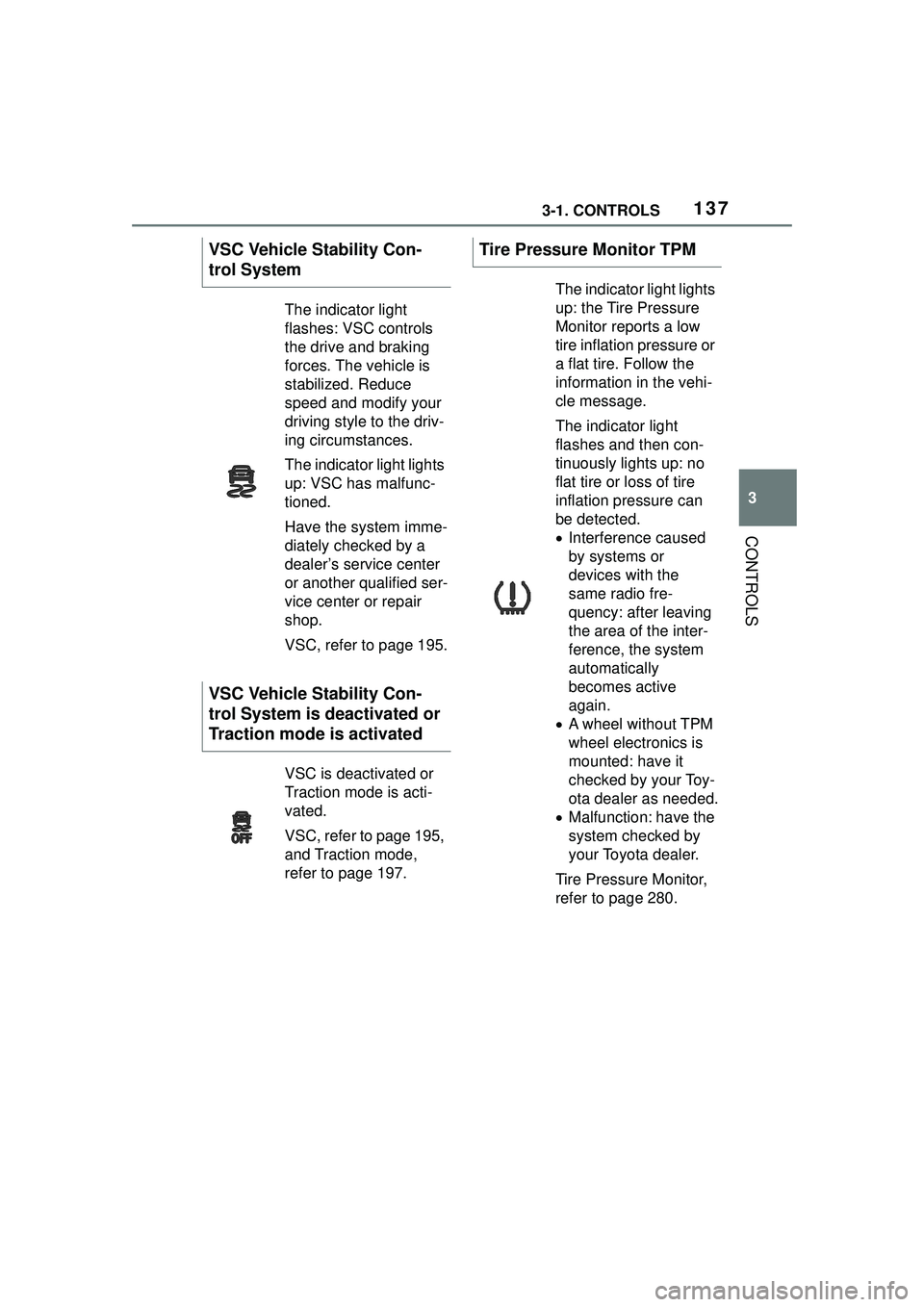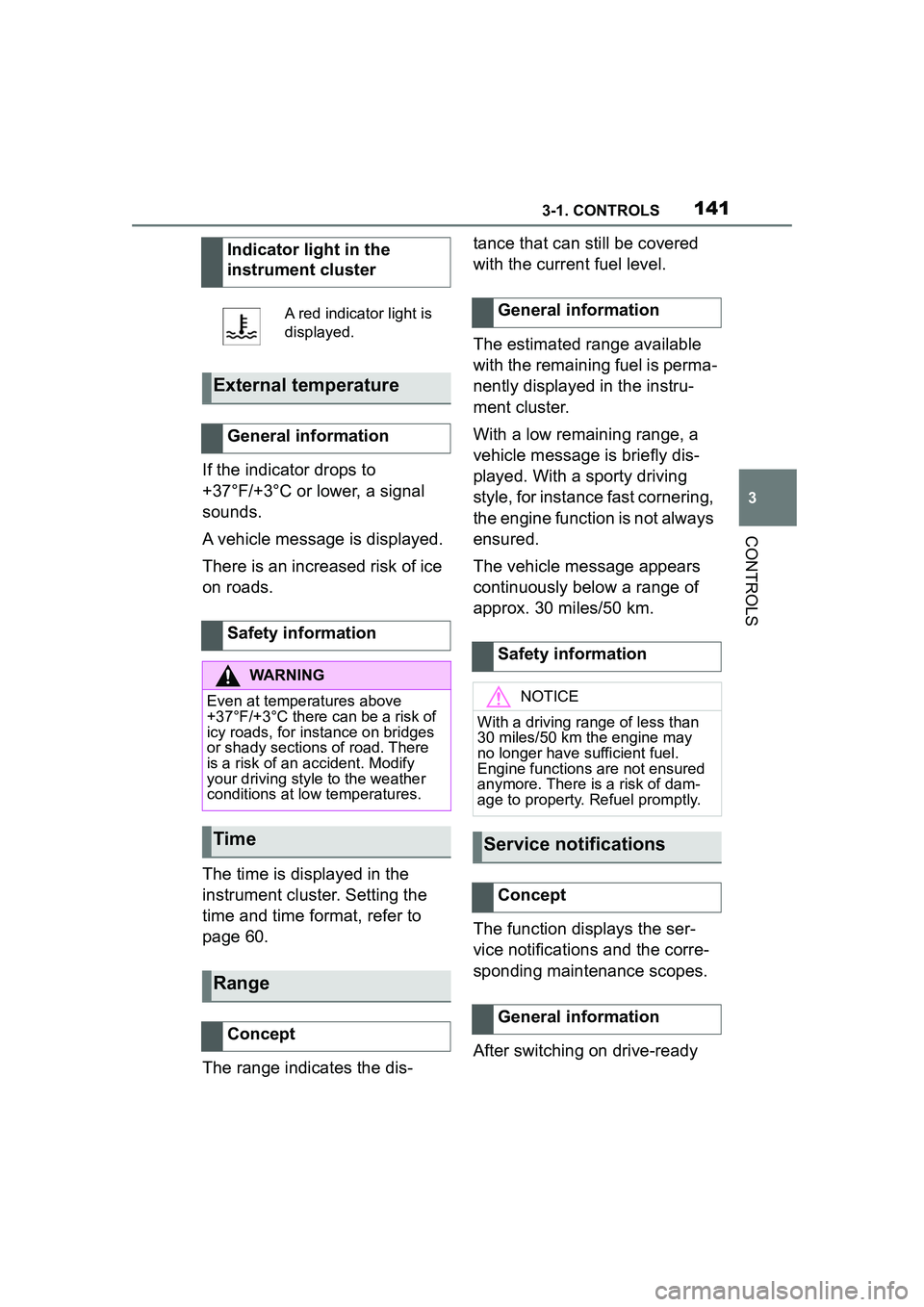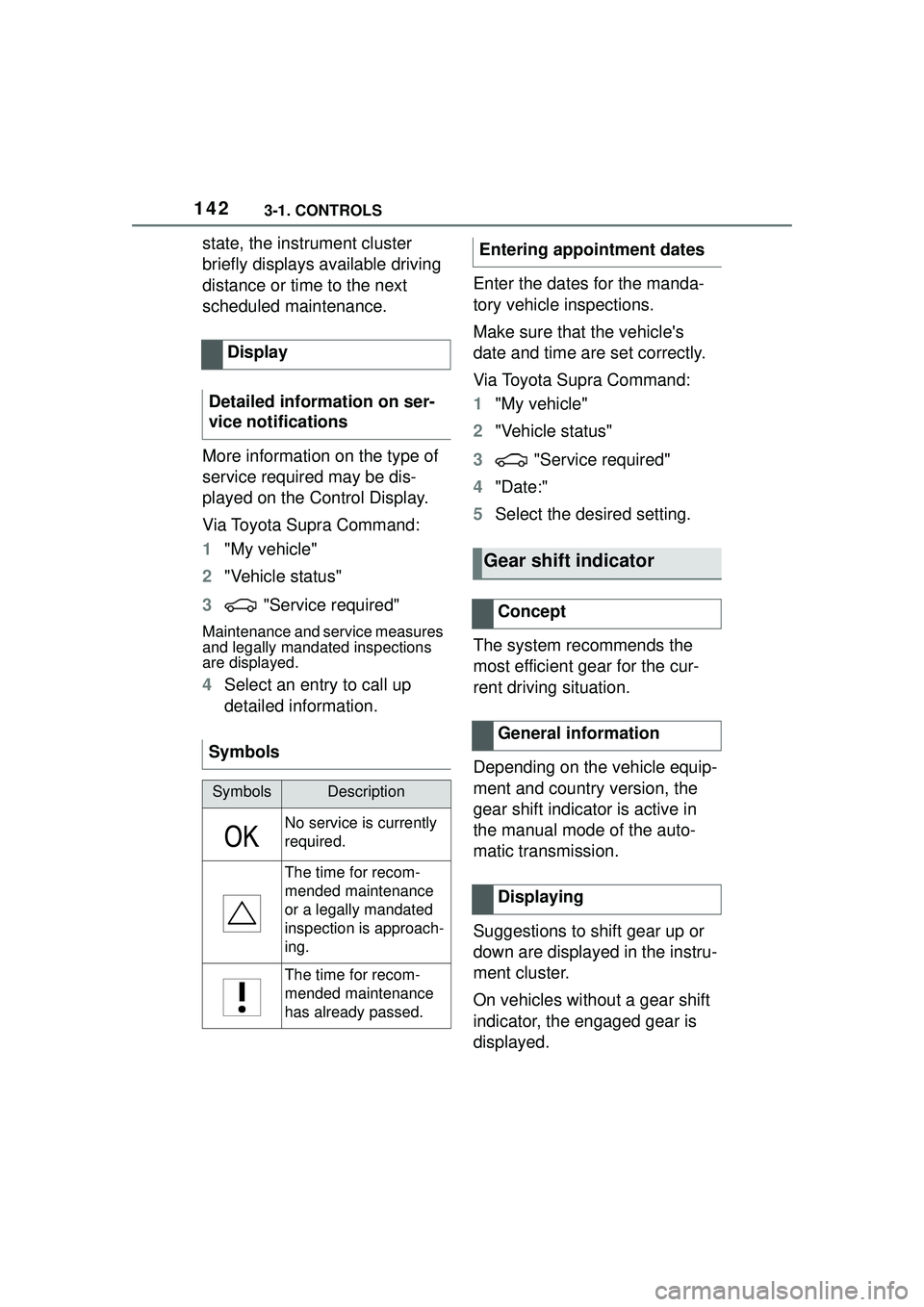2022 TOYOTA GR SUPRA service indicator
[x] Cancel search: service indicatorPage 137 of 356

1373-1. CONTROLS
3
CONTROLS
VSC Vehicle Stability Con-
trol System
The indicator light
flashes: VSC controls
the drive and braking
forces. The vehicle is
stabilized. Reduce
speed and modify your
driving style to the driv-
ing circumstances.
The indicator light lights
up: VSC has malfunc-
tioned.
Have the system imme-
diately checked by a
dealer’s service center
or another qualified ser-
vice center or repair
shop.
VSC, refer to page 195.
VSC Vehicle Stability Con-
trol System is deactivated or
Traction mode is activated
VSC is deactivated or
Traction mode is acti-
vated.
VSC, refer to page 195,
and Traction mode,
refer to page 197.
Tire Pressure Monitor TPM
The indicator light lights
up: the Tire Pressure
Monitor reports a low
tire inflation pressure or
a flat tire. Follow the
information in the vehi-
cle message.
The indicator light
flashes and then con-
tinuously lights up: no
flat tire or loss of tire
inflation pressure can
be detected.
Interference caused
by systems or
devices with the
same radio fre-
quency: after leaving
the area of the inter-
ference, the system
automatically
becomes active
again.
A wheel without TPM
wheel electronics is
mounted: have it
checked by your Toy-
ota dealer as needed.
Malfunction: have the
system checked by
your Toyota dealer.
Tire Pressure Monitor,
refer to page 280.
Page 141 of 356

1413-1. CONTROLS
3
CONTROLS
If the indicator drops to
+37°F/+3°C or lower, a signal
sounds.
A vehicle message is displayed.
There is an increased risk of ice
on roads.
The time is displayed in the
instrument cluster. Setting the
time and time format, refer to
page 60.
The range indicates the dis-tance that can still be covered
with the current fuel level.
The estimated range available
with the remaining fuel is perma-
nently displayed in the instru-
ment cluster.
With a low remaining range, a
vehicle message is briefly dis-
played. With a sporty driving
style, for instance fast cornering,
the engine function is not always
ensured.
The vehicle message appears
continuously below a range of
approx. 30 miles/50 km.
The function displays the ser-
vice notifications and the corre-
sponding maintenance scopes.
After switching on drive-ready
Indicator light in the
instrument cluster
A red indicator light is
displayed.
External temperature
General information
Safety information
WARNING
Even at temperatures above
+37°F/+3°C there can be a risk of
icy roads, for inst
ance on bridges
or shady sections of road. There
is a risk of an accident. Modify
your driving style to the weather
conditions at low temperatures.
Time
Range
Concept
General information
Safety information
NOTICE
With a driving range of less than
30 miles/50 km the engine may
no longer have sufficient fuel.
Engine functions are not ensured
anymore. There is a risk of dam-
age to property. Refuel promptly.
Service notifications
Concept
General information
Page 142 of 356

1423-1. CONTROLS
state, the instrument cluster
briefly displays available driving
distance or time to the next
scheduled maintenance.
More information on the type of
service required may be dis-
played on the Control Display.
Via Toyota Supra Command:
1"My vehicle"
2 "Vehicle status"
3 "Service required"
Maintenance and service measures
and legally mandated inspections
are displayed.
4Select an entry to call up
detailed information. Enter the dates for the manda-
tory vehicle inspections.
Make sure that the vehicle's
date and time are set correctly.
Via Toyota Supra Command:
1
"My vehicle"
2 "Vehicle status"
3 "Service required"
4 "Date:"
5 Select the desired setting.
The system recommends the
most efficient gear for the cur-
rent driving situation.
Depending on the vehicle equip-
ment and country version, the
gear shift indicator is active in
the manual mode of the auto-
matic transmission.
Suggestions to shift gear up or
down are displayed in the instru-
ment cluster.
On vehicles without a gear shift
indicator, the engaged gear is
displayed.
Display
Detailed information on ser-
vice notifications
Symbols
SymbolsDescription
No service is currently
required.
The time for recom-
mended maintenance
or a legally mandated
inspection is approach-
ing.
The time for recom-
mended maintenance
has already passed.
Entering appointment dates
Gear shift indicator
Concept
General information
Displaying
Page 288 of 356

2885-1. MOBILITY
Perform a system reset again.
• Tire Pressure Monitor mal- function: have the system
checked by a manufacturer
service center or another
qualified service center or
repair shop.
• Each tire, including the spare (if provided) should be
checked monthly when cold
and inflated to the inflation
pressure recommended by
the vehicle manufacturer on
the vehicle placard or tire
inflation pressure label. (If
your vehicle has tires of a dif-
ferent size than the size indi-
cated on the vehicle placard
or tire inflation pressure label,
you should determine the
proper tire inflation pressure
for those tires.) As an added
safety feature, your vehicle
has been equipped with a tire
pressure monitoring system
(TPMS) that illuminates a low
tire pressure telltale when one
or more of your tires is signifi-
cantly under-inflated. Accord-
ingly, when the low tire
pressure telltale illuminates,
you should stop and check
your tires as soon as possi-
ble, and inflate them to the
proper pressure. Driving on a significantly under-inflated tire
causes the tire to overheat
and can lead to tire failure.
Under-inflation also reduces
fuel efficiency and tire tread
life, and may affect the vehi-
cle's handling and stopping
ability. Please note that the
TPMS is not a substitute for
proper tire maintenance, and
it is the driver's responsibility
to maintain correct tire pres-
sure, even if under-inflation
has not reached the level to
trigger illumination of the
TPMS low tire pressure tell-
tale. Your vehicle has also
been equipped with a TPMS
malfunction indicator to indi-
cate when the system is not
operating properly. The TPMS
malfunction indicator is com-
bined with the low tire pres-
sure telltale. When the system
detects a malfunction, the tell-
tale will flash for approxi-
mately one minute and then
remain continuously illumi-
nated. This sequence will
continue upon subsequent
vehicle start-ups as long as
the malfunction exists. When
the malfunction indicator is
illuminated, the system may
not be able to detect or signal
low tire pressure as intended.
TPMS malfunctions may
occur for a variety of reasons,
including the installation of
replacement or alternate tires
Declaration according to
NHTSA/FMVSS 138 Tire
Pressure Monitoring System
Page 347 of 356

347Alphabetical Index
Daytime running lights .......... 155
Defogging the windows ......... 230
Defrosting the windows ......... 230
Deleting personal data ............. 64
Departure time, parked-car venti-
lation...................................... 233
Device list, displaying .............. 75
Devices, managing ................... 75
Diagnosis connect ion ............ 302
Differential oil ......................... 332
Dimensions ............................. 330
Dimmable exterior mirrors .... 106
Dimmable interior mirror ....... 106
Direct dial buttons, see Program- mable memory buttons.......... 56
Direction indicator, see Turn sig- nals ........................................ 121
Display in the windshield, see Head-up Display ................... 150
Display lighting, see Instrument lighting .................................. 158
Displays .................................. 133
Displays and symbols ............... 4
Displays, screens ................... 328
Disposal, coolant ................... 299
Disposal, vehicle battery ....... 306
Distance control, see Parking Sensors ................................. 213
Driver assistance, see Toyota Supra Safety ......................... 172
Driver attention control.......... 192
Driver Fatigue Detector.......... 192
Driver profiles ........................... 65
Drive-ready state, idle state, and standby state .......................... 44
Driving Assistant, see Toyota Supra Safety ......................... 172
Driving comfort ...................... 224
Driving instructions, break-in252
Driving mode, see Sport mode switch .................................... 131
Driving notes, general ........... 253 Driving on racetracks .............257
Driving stability control systems
...............................................194
Driving tips ..............................253
Drying air, see Air conditioning ...............................................228
Dynamic radar cruise control with full-speed range............203
E
Electronic oil measurement...295
Emergency brake function when parking, Parking Sensors with
emergency braking function216
Emergency service, see Break- down assistance ...................315
Emergency unlocking, fuel filler flap .........................................263
Emergency unlocking, transmis- sion lock ................................130
Energy savings, see Gear shift indicator ................................142
Engine......................................331
Engine compartment ..............291
Engine compartment, working in ...............................................291
Engine coolant ........................298
Engine coolant, Capacity .......332
Engine oil ........................294, 331
Engine oil change ...................298
Engine oil filler neck...............296
Engine oil temperature...........140
Engine oil types to add ..........297
Engine oil, adding...................296
Engine start, jump-starting ....317
Engine temperature ................140
Engine, Auto Start/Stop function ............................................... 116
Entry comparison, navigation .46
Equipment, interior.................234
Error displays, see Vehicle mes- sages .....................................134